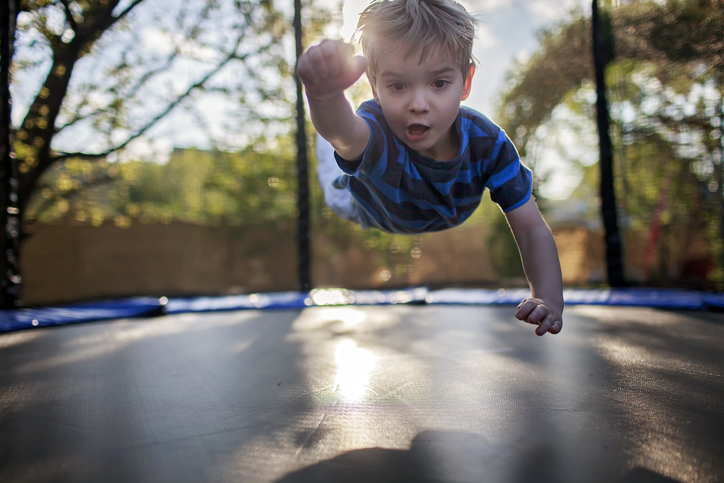Attractive Nuisances & Premises Liability Lawsuits
Jeffrey Breit—February 16, 2018

What Is an “Attractive Nuisance?”
Often, the very things meant to enhance your property or bring entertainment are inherently dangerous, especially for children. Things like swimming pools, playground equipment, and trampolines are both inviting and hazardous. In many instances, children and teenagers are attracted to properties, projects, and objects because they are dangerous. Construction sites, remodeling projects, tools, and even weapons can all be irresistible to minors. These and other similar conditions that have the potential to lure children to a property are all considered “attractive nuisances.”
Attractive nuisance laws are meant to protect children and teens from objects and properties that are both alluring and dangerous. Property owners are required by law to take reasonable measures to keep visitors safe. This means fixing any unsafe conditions in a timely manner or, at the very least, warning guests of these dangerous conditions. In regards to attractive nuisances, however, property owners are required to take certain safety precautions to protect children—even when those children are trespassing.
Attractive Nuisances Can Be a Liability for Property Owners
Why are children trespassers treated differently than adults who trespass? Essentially, due to their age, minors cannot be considered negligent. Children, even those who have been warned of potential dangers, are inherently curious and are typically unable to fully consider the risks associated with an attractive nuisance, such as a swimming pool, swing set, or construction site. This is particularly true for very young children under the age of six or seven. Because of this, the responsibility of safety falls on the shoulders of the adult property owner.
A property owner may be liable if a child or teen is injured by an attractive nuisance on his or her property and the following conditions are true:
- The property owner knew or should have known a condition on the property made it likely for children to trespass.
- The attractive nuisance or property condition caused or has the potential to cause the injury or death of a child or teen.
- The minors involved in the accident were not old enough to understand and/or weigh the risks created by the property condition.
- The condition’s risk to children outweighs the cost of maintaining or remedying the attractive nuisance.
- The property owner failed to take appropriate measures to maintain safety and/or eliminate potential dangers caused by the condition.
For example, if a property owner has a swimming pool in her backyard, she should be aware that this can attract young children and that young children could potentially fall in and drown. If she fails to take any reasonable safety measures, such as installing a locked fence around the pool, and a young child does fall in and drown, the property owner could be held liable.
Keeping Your Property Safe for Children
Property owners should take the time to enact certain safety precautions—not only to protect themselves from liability but also, more importantly, to protect children who cannot protect themselves. This applies to all types of property owners, ranging from private homeowners to apartment building managers to other commercial property owners.
Water Features
Drowning is one of the leading attractive nuisance-related accidents, and it doesn’t only apply to swimming pools. Fountains, ponds, wells, and other water features all pose a risk to children. Property owners can install walls and fences around water features as a safety precaution. Walls and fences should be at least four feet high, difficult to climb, and have the ability to lock. Ideally, locked fences and gates should have an alarm mechanism. Pool owners can take further precautions by installing a pool cover, ensuring that there is a life ring in the pool area, and posting safety warnings.
Playground Equipment
Playground equipment, particularly swing sets, are also a leading cause of child injuries. Swing sets and other playground equipment should meet minimum safety standards, such as spacing swings at least two feet (24 inches) apart. It is also a good idea to install a shock-absorbing surface below playground equipment, as falls are one of the most common causes of injury. Trampolines should have a safety net and should be set on a shock-absorbing surface as well. If you own any playground equipment or have a trampoline, zip line, or similar structure in your yard, it is a good idea to make sure it is enclosed by a secure fence or wall.
Construction Sites
If you are remodeling your home or property, you should make sure that the construction site is reasonably safe by removing tools after you are done using them, laying ladders down on the ground, and placing all debris in locked dumpsters. You should also install fencing around the construction area and make sure that it is locked and secure when you finish working for the day.
These are just a few ways in which you can keep your property reasonably safe for children, even in the event that they are trespassing. If you have questions about an attractive nuisance or premises liability case, please feel free to contact our Virginia Beach premises liability lawyers for a free consultation.
How Attractive Nuisances Lead to Premises Liability Lawsuits
If a child or teen is injured or killed due to an attractive nuisance, the child’s parent, guardian, or another relative may file a personal injury or wrongful death suit against the property owner. To do so, the plaintiff must show that the property owner knew of the attractive nuisance and was also aware (or should have been aware) that this condition would attract children to the property. The plaintiff must also show the property owner did not take reasonable measures to protect children from the attractive nuisance and that the child involved was not old enough to make rational decisions regarding the risks of the condition.
If your child was harmed as a result of a dangerous condition on someone else’s property, you may be able to take legal action. This is true regardless of whether your child suffered injuries on public or private property. Even if your child was on private property unbeknownst to the landowner, you may be able to pursue compensation for damages if the landowner failed to enact property safety precautions. It is important that you speak with an experienced premises liability lawyer who can help you determine who is responsible for your child’s injuries. Get in touch with the team at Breit Biniazan to schedule a free initial case evaluation today.
By Jeffrey Breit
Partner
Jeffrey Breit is driven to be the best in personal injury legal representation and has had far-reaching accomplishments that will be felt for years to come. Throughout a successful career as a personal injury lawyer in Virginia Beach and the larger state of Virginia, Jeffrey Breit has continued to work hard to improve the reputation of attorneys representing injured people, as well as training the next generation of trial lawyers.
Categories:
Office Locations
Related Posts
Categories
We are personal injury attorneys
Fill out our contact form to speak to our experienced Virginia trial attorneys. Breit Biniazan has helped recover millions of dollars in cases. Learn how we can help you today.
